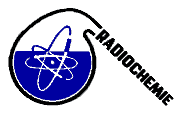Speaker
Prof.
Jukka Lehto
(Laboratory of Radiochemistry, Department of Chemistry, University of Helsinki)
Description
129I is a long-lived beta-emitting (Emax 154,4 keV) radioisotope of iodine. Its half-life is 15,7 million years. 129I is produced mainly by human nuclear activities and especially it has been released to the environment from the spent nuclear fuel reprocessing plants. In the pre-nuclear era 129I/127I ratios in the environment were approximately 10-12. Nowadays 129I/127I ratios have reached values from 10-10 to 10-4.
In this study, activity concentrations of 129I and its distribution into various chemical species (iodide I-, iodate IO3- and bound in organics) were analyzed from four different lakes in Finland and from four different sea locations on the Gulf of Finland, the Bothnian Sea and the Bothnian Bay. 129I was also analyzed from four rainwater samples. Samples were taken in the summer of 2009.
After filtering the 0.3 l water samples, separation of various iodine species was done by anion exchange chromatography: 129IO3- passes through an anion exchange resin bed in NO3- form while 129I- absorbs into the bed. 129I- is eluted from resin with NaClO. Finally samples were precipitated by AgNO3 to form AgI and 129I was measured by accelerator mass spectrometry (AMS). Stable iodine (127I) was analyzed by inductively coupled plasma mass spectrometry (ICP-MS).
First results from a lake in the southern Finland and from water taken from the Finnish Bay in front of Helsinki show that levels of 129I in lake water are around 1×109 atoms per litre while in sea water the levels are 4-5 times higher. 129I occurs both in lake and sea water mainly in iodide form and the fraction of iodate form is only about 5%. The 129I/127I ratio has clearly elevated compared to natural levels, and are approximately the same in sea and in lake, 14×10-8 and 8×10-8, respectively. These results are only preliminary and a better picture of the situation will be obtained after finalizing the project. The results obtained so far are, however, at the same level as obtained in Swedish studies at the same latitudes.
Primary author
Dr
Tero Räty
(University of Helsinki, Laboratory of Radiochemistry, Helsinki, Finland)
Co-authors
Dr
Göran Possnert
(University of Uppsala, Uppsala, Sweden)
Harri Kankaanpää
(Finnish Environment Institute, Helsinki, Finland)
Dr
Juha Flinkman
(Finnish Environment Institute, Helsinki, Finland)
Prof.
Jukka Lehto
(Laboratory of Radiochemistry, Department of Chemistry, University of Helsinki)
Dr
Jussi Paatero
(Finnish Meteorological Institute, Helsinki, Finland)
Dr
Xiaolin Hou
(Technical University of Denmark, Risö, Denmark)

